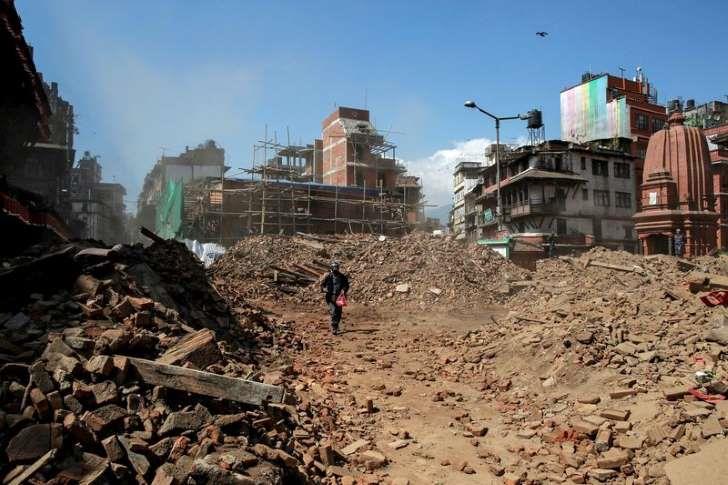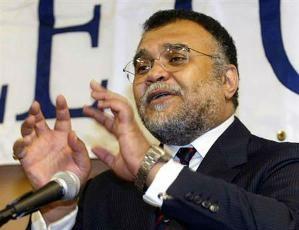April 28, 2015
KATHMANDU, NEPAL – Shock turned to anger in Nepal on Tuesday as some of the tens of thousands stricken by a devastating earthquake, which killed more than 4,000 people, expressed frustration at what they said was their government's slow response to the crisis.

April 28, 2015
KATHMANDU, NEPAL – Shock turned to anger in Nepal on Tuesday as some of the tens of thousands stricken by a devastating earthquake, which killed more than 4,000 people, expressed frustration at what they said was their government's slow response to the crisis.

Member of Nepalese police personnel walks amidst the rubble of collapsed buildings, in the aftermath of Saturday's earthquake in Kathmandu, Nepal
International aid has finally begun arriving in the Himalayan nation of 28 million people after the major quake that struck at about midday on Saturday. A Home Ministry official in the capital, Kathmandu, said the death toll from the 7.9 magnitude quake stood at 4,010, with 7,598 injured.
Nepal's most deadly quake in 81 years triggered a huge avalanche on Mount Everest that killed at least 17 climbers and guides, including foreigners, the worst single disaster on the world's highest peak.
A series of aftershocks, severe damage from the quake, creaking infrastructure and a lack of funds have slowed the disbursement of aid to those most in need.
The head of neighboring India's National Disaster Response Force (NDRF), one of the first foreign organizations to arrive in Nepal to help in the search and rescue effort, said finding survivors and the bodies of the dead would take time.
NDRF Director General O.P. Singh said heavy equipment could not fit through many of the narrow streets of Kathmandu. "You have to remove all this rubble, so that will take a lot of time … I think it's going to take weeks," he told Indian television channel NDTV late on Monday.
Many people across Nepal slept in the open for a third night, their homes either flattened or threatened by tremors that spread more fear among a traumatized population. In Kathmandu, as elsewhere, thousands are sleeping on pavements, roads and in parks, many under makeshift tents. Hospitals are full to overflowing, while water, food and power are scarce, raising fears of waterborne diseases.
With aid slow to reach many of the most vulnerable, some Nepalis were critical of the government.
"The government has not done anything for us," said Anil Giri, who was with about 20 volunteers looking for two of his friends presumed buried under rubble. "We are clearing the debris ourselves with our bare hands."
Officials acknowledged they were overwhelmed by the scale of the disaster.
"The big challenge is relief," said Chief Secretary Leela Mani Paudel, Nepal's top bureaucrat. "We urge foreign countries to give us special relief materials and medical teams. We are really desperate for more foreign expertise to pull through this crisis."
"MY DUTY TO FIND HER"
The situation is worse in remote rural areas. Highways have been blocked by landslides, and many villages and communities are without water and electricity, surviving on salvaged food and with no outside help.
While aid has begun arriving in the capital, including food, medical supplies, tents and dogs trained for rescue efforts, the authorities are struggling to deliver relief further afield. Time is running out to find survivors among the rubble of collapsed buildings. In the north of Kathmandu, survivors suspended their search overnight, with plans to resume early on Tuesday.
"We cannot look for missing people … with a candle in our hands," said Amarnath Prasad, 26, a musician who was helping his best friend look for his missing mother. "She loved me like her son, and I think it is my duty to find her, dead or alive," said Prasad.
Families and friends of the victims lit hundreds of funeral pyres in towns and the countryside.
Foreign countries escalated efforts to get medical equipment, medicine, food, water, blankets, tents and search-and-rescue teams into Nepal, but chaotic scenes at the main international airport slowed the flow of aid.
India and China were among the first contributors to an international effort to support Nepal's stretched resources. On Monday, the United States announced an additional $9 million in aid for Nepal, bringing total U.S. disaster funding to $10 million.
U.S. Defence Secretary Ash Carter said two C-17 U.S. Air Force transport planes carrying search-and-rescue personnel and supplies were headed to Nepal. Australia is also sending a C-17 to deliver disaster relief supplies, Foreign Minister Julie Bishop said, and to start ferrying out some of the more than 1,150 Australians who were in Nepal when the quake struck.
High in the Himalayas, hundreds of climbers from around the world were reeling from the avalanche that swept through Everest base camp in a few terrifying moments when the quake struck. Many Nepalese sherpa mountain guides had descended to their homes and villages to see if loved ones were safe. Foreign mountaineers, meanwhile, were divided over whether to continue their pursuit of scaling the surrounding peaks if their local guides returned to lead them.
"For me personally it's probably too early to say how I feel about that," said Canadian Nick Cienski, who is attempting a record ascent of six 8,000-metre peaks this calendar year. "I wouldn't want to continue if it made anybody uncomfortable to continue, sherpas included in that."
Romanian climber Alex Gavan, who had microblogged his eyewitness account of the avalanche and its aftermath, said he had left Everest base camp to help the earthquake relief effort.
"The time is not for climbing now, but for helping Nepali people," he posted on Twitter on Monday.
Courtesy: Reuters















































































































